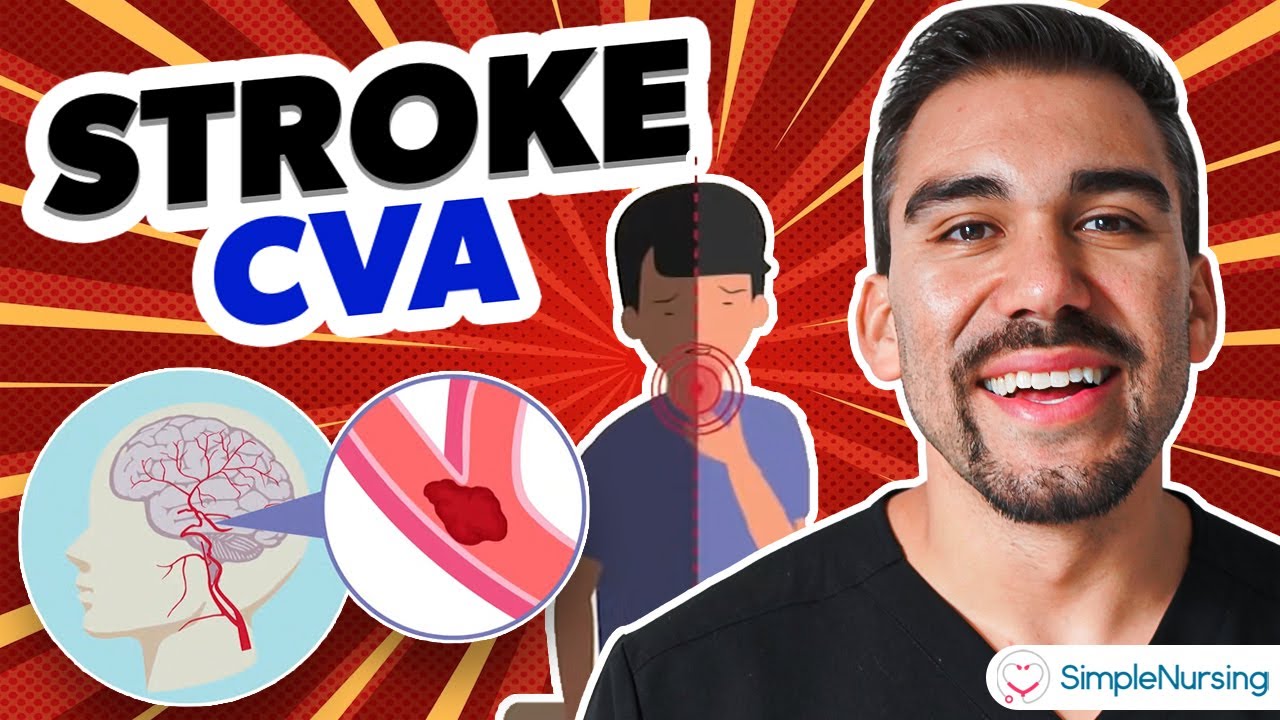Stroke Pathogenesis (with a focus on Ischemic Stroke)
Summary
TLDRIn this video from the Calgary Guide series, the pathogenesis of stroke is discussed, focusing on the four main types: acute ischemic stroke, intracerebral hemorrhage, subarachnoid hemorrhage, and venous sinus thrombosis. The video explains the causes and mechanisms behind each type, emphasizing how they lead to impaired blood supply and symptoms in the brain. A detailed discussion of acute ischemic stroke is also included, highlighting its causes and effects on cerebral blood flow, neuronal damage, and inflammation. Viewers are encouraged to support the non-profit medical education effort by liking and subscribing to the channel.
Takeaways
- 🧠 There are four main types of stroke: acute ischemic stroke, intracerebral hemorrhage, subarachnoid hemorrhage, and venous sinus thrombosis.
- 🩸 Acute ischemic stroke can be caused by a blood clot traveling to the brain or dislodgement of an atherosclerotic plaque.
- 🚫 Chronic hypertension can lead to the formation of microaneurysms, causing intracerebral hemorrhage.
- 🧬 Amyloid deposits and tumors can cause blood vessel rupture and bleeding within the brain parenchyma.
- 🤕 Traumatic head injuries can lead to both intracerebral hemorrhage and subarachnoid hemorrhage by damaging blood vessels.
- 🩹 Venous sinus thrombosis is often caused by a hypercoagulable state due to various factors like genetic predisposition or use of birth control pills.
- 🔍 The pathogenesis of ischemic stroke includes small artery occlusion, large artery atherosclerosis, and cardioaortic embolism.
- 🧬 Reduced cerebral blood flow from any cause of ischemic stroke leads to a cascade of events including anaerobic metabolism, brain edema, and inflammation.
- 💊 Excitotoxicity from increased glutamate levels contributes to neuronal damage and inflammation in ischemic stroke.
- 🔄 The accumulation of lactate and the release of cytokines from damaged astrocytes and microglia further contribute to brain inflammation.
- 📉 Ischemic stroke results in characteristic symptoms like weakness, slurred speech, visual field losses, and autonomic dysfunction due to the complex interplay of necrosis and inflammation.
Q & A
What are the four main types of stroke mentioned in the video?
-The four main types of stroke mentioned are acute ischemic stroke, intracerebral hemorrhage, subarachnoid hemorrhage, and venous sinus thrombosis.
What are the two main pathophysiological causes of acute ischemic stroke?
-The two main causes are a blood clot formed in the left side of the heart traveling to the brain and the dislodgement of an atherosclerotic plaque formed in the internal carotid arteries traveling to the brain.
How does chronic hypertension contribute to stroke?
-Chronic hypertension can cause microaneurysms to form in the small arteries of the brain, leading to hypertensive hemorrhage and potentially resulting in intracerebral hemorrhage.
What is the role of amyloid deposits in the context of stroke?
-Amyloid deposits can cause vascular fragility, leading to the rupture of blood vessels within the brain and resulting in bleeding within the brain parenchyma.
What are the three common causes of subarachnoid hemorrhage?
-The three common causes are arterial venous malformation, traumatic head injury leading to a cerebral contusion that damages blood vessels in the subarachnoid space, and a ruptured arterial aneurysm.
How does venous sinus thrombosis typically occur?
-Venous sinus thrombosis usually occurs due to a hypercoagulable state caused by hereditary or familial causes, exogenous estrogen such as birth control pills, or pregnancy and postpartum situations.
What is the impact of reduced cerebral blood flow on brain tissue during an ischemic stroke?
-Reduced cerebral blood flow leads to a reduction of oxygen and glucose provided to the brain tissue, resulting in increased anaerobic metabolism, which is inefficient and reduces the amount of ATP available to neurons.
How does the lack of ATP affect the function of neurons during an ischemic stroke?
-The lack of ATP reduces the function of sodium-potassium pumps on the surface of neurons, leading to sodium accumulation in the interstitial tissues of the brain and water movement by osmosis, causing brain edema.
What is excitotoxicity and how does it contribute to brain damage during a stroke?
-Excitotoxicity is a condition where an increased amount of glutamate, a neurotransmitter, contributes to neuronal damage. This results in increased calcium influx into neurons, activating catabolic enzymes and contributing to oxidative and nitrosative injury, leading to necrosis of brain tissue.
What is the significance of the blood-brain barrier breakdown during a stroke?
-The breakdown of the blood-brain barrier during a stroke leads to inflammation in the brain, known as secondary inflammation, and allows for the infiltration of immune cells and proteins that can exacerbate brain damage.
How does the accumulation of lactate contribute to brain damage following a stroke?
-The accumulation of lactate, a byproduct of increased anaerobic metabolism, is dangerous to brain tissue, leading to astrocyte death and the release of cytokines like TNF-alpha into the cerebral fluid, contributing to inflammation in the affected area.
Outlines

Cette section est réservée aux utilisateurs payants. Améliorez votre compte pour accéder à cette section.
Améliorer maintenantMindmap

Cette section est réservée aux utilisateurs payants. Améliorez votre compte pour accéder à cette section.
Améliorer maintenantKeywords

Cette section est réservée aux utilisateurs payants. Améliorez votre compte pour accéder à cette section.
Améliorer maintenantHighlights

Cette section est réservée aux utilisateurs payants. Améliorez votre compte pour accéder à cette section.
Améliorer maintenantTranscripts

Cette section est réservée aux utilisateurs payants. Améliorez votre compte pour accéder à cette section.
Améliorer maintenantVoir Plus de Vidéos Connexes

Hemorrhagic stroke: intracerebral hemorrhage - causes, symptoms, diagnosis, treatment, pathology

Tenecteplase for Ischemic Stroke at 4.5 to 24 Hours | NEJM

STROKE Lengkap - Klasifikasi, Patofisiologi, Skor Siriraj, Gajah Mada, Latihan Soal UKMPPD

Stroke CVA (Cerebrovascular Accident) Hemorrhagic, Ischemic NCLEX RN & LPN NURSING

What Causes a Stroke?

Penyebab Pecah Pembuluh Darah Di Otak
5.0 / 5 (0 votes)
